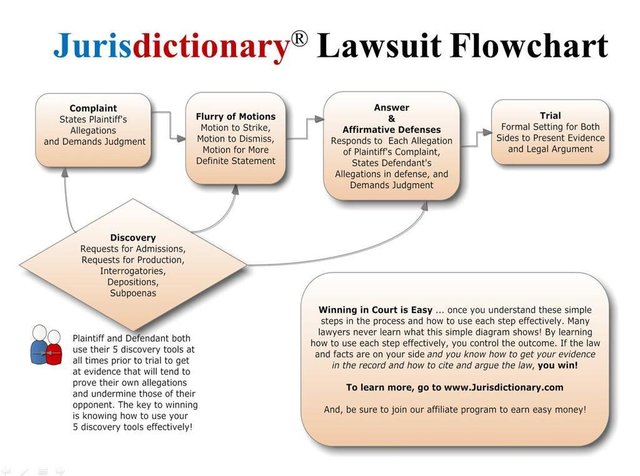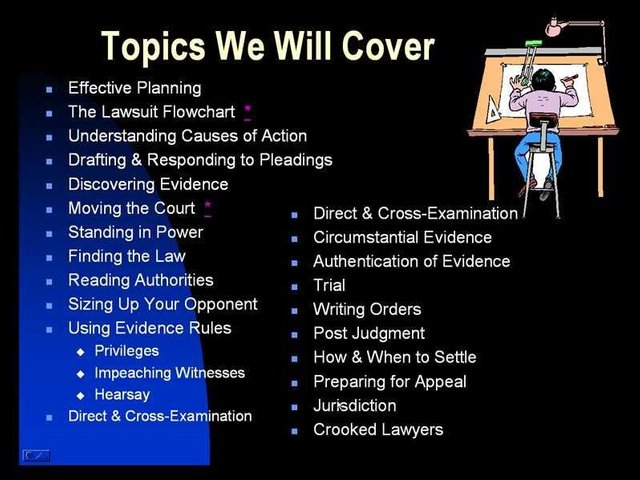No Lawyer? No Problem! Learn To Win Here!

Do You Have Legal Problems?
Can't Afford A Lawyer?
Want To Learn How To Win In Just A Few Hours And Get Justice For Yourself And Your Loved Ones?
Learn How Here With This Amazing Legal Self-Help Course.
RULES OF PROCEDURE:
You have a right to do anything lawyers do.
Just follow the rules you learn in this course.
The rules of procedure provide powerful opportunities for you to plead your case, move the court, get your evidence in, keep your opponent's evidence out, and make an official record you can present to an appeals court if you lose at the trial level.
This course makes procedure rules easy to learn and use!
RULES OF EVIDENCE:
You have a right to get evidence into the court's official record.
You have a right to force evidence from my opponents and even from people who aren't parties to your case, like banks, phone companies, government agencies, etc.
You have a right to prevent your opponent from putting confusing or deceptive evidence into the record.
This course explain hearsay, examining witnesses on the stand, taking depositions, best evidence rule, courtroom objections, etc.
MOVING THE COURT:
You have a right to move the court to enter orders in you favor.
This course will show you how to move the court and get the orders you need to win.
NOTHING TO LOSE:
You have a right to a full refund if you don't believe the course will help you win.
Just call the Toll Free number within 24 hours after ordering.
You will receive full refund next business day.
Complete Court Procedure - Step-by-Step
Know How to Win Without a Lawyer in 2 Days
One Year Subscription - Only $249
( Extra Years Only $89 for Early Renewers)
Lawsuits remain a mystery to those who don’t know how to “take them
apart” to understand the relationships of their component phases.
Jurisdictionary® Lawsuit Flowchart shows you the five (5) phases of every
lawsuit (state or federal jurisdictions).

As you see, there are 3 MAIN phases and 2 INTERMEDIATE phases.
• Complaint – Answer -- Trial (The initial letters spell CAT!)
• Flurry of Motions -- Discovery
Lawsuits are won by making a record of the FACTS & LAW during each of
the five phases.
To win as plaintiff, you merely meet your burden to prove that
the facts and controlling law in your jurisdiction agree.
To win as defendant,
you merely prove that the plaintiff’s facts and law do not agree, so plaintiff
cannot meet his burden.
During each phase, plaintiff tries to meet his burden, while defendant does
all he can to shoot holes in the plaintiff’s case.
It’s really that simple!
Protect yourself from other members of the same profession
Order thecomplete tutorials “The Works!” at www.jurisdictionary.com
COMPLAINT … Plaintiff concisely and clearly states all facts necessary to
win … and says no more than necessary.
Plaintiff also concisely and clearly
states the law that, if stated facts are proven true, will give him a favorable
verdict “according to law”.
The power of law exists whenever necessary facts are proven to exist. In order to win a lawsuit, therefore, you must prove not only
that the necessary facts are true but that, if those facts are true, there is a law that provides a court-enforced remedy for your damages resulting from the facts.
FLURRY OF MOTIONS … Defendant files motions to dismiss, to strike, or for more definite statement and requires plaintiff to prove his complaint is legitimate.
Flurry of motions is used by defendant to get rid of the case. If successful, defendant doesn’t have to file an answer to plaintiff’s complaint. A flurry of motions can even succeed where plaintiff was “in the right” if plaintiff failed to include in his complaint sufficient facts to state a cause of action, made statements
that were impertinent or scandalous, or used such poor English as to make it impossible for the Court to understand his case.
ANSWER … If the flurry of motions fails defendant must answer each allegation of plaintiff’s complaint by admitting, denying, or claiming no knowledge.
Defendant should answer no more than necessary to deny what plaintiff has alleged. If defendant has defenses, however, he should state these in his answer as affirmative defenses (or he may waive the right to raise the defensive issues at a later time).
Now also is time for counterclaims or to bring in a third-party defendant, i.e., one whom the defendant wishes to blame for his having been sued in the first place.
DISCOVERY … By using requests for admissions, requests for production, interrogatories, depositions, and Court’s subpoena power facts are put on
the court’s record. During this critical phase, both sides attempt to make a record of the truth.
This is the most important phase of every lawsuit.
Failure to make an effective court record of the facts during the discovery phase is the single greatest cause of people losing otherwise winnable lawsuits!
Be thorough!
TRIAL … Trial happens if defendant fails to get plaintiff’s case dismissed, or the parties fail to sooner establish facts by discovery to promote settlement.
Successful litigants make a winning record before trial, using the procedures and tactics taught by these simplified lawsuit tutorials.
They establish winning facts and supporting law on the court record before trial begins.
This is the riskiest phase of any lawsuit.
Jurisdictionary® recommends you go to trial only after ordering and carefully
studying all of their lawsuit tutorials … even if you have the assistance of an experienced trial lawyer.

@reported has voted on behalf of @minnowpond. If you would like to recieve upvotes from minnowpond on all your posts, simply FOLLOW @minnowpond. To be Resteemed to 4k+ followers and upvoted heavier send 0.25SBD to @minnowpond with your posts url as the memo